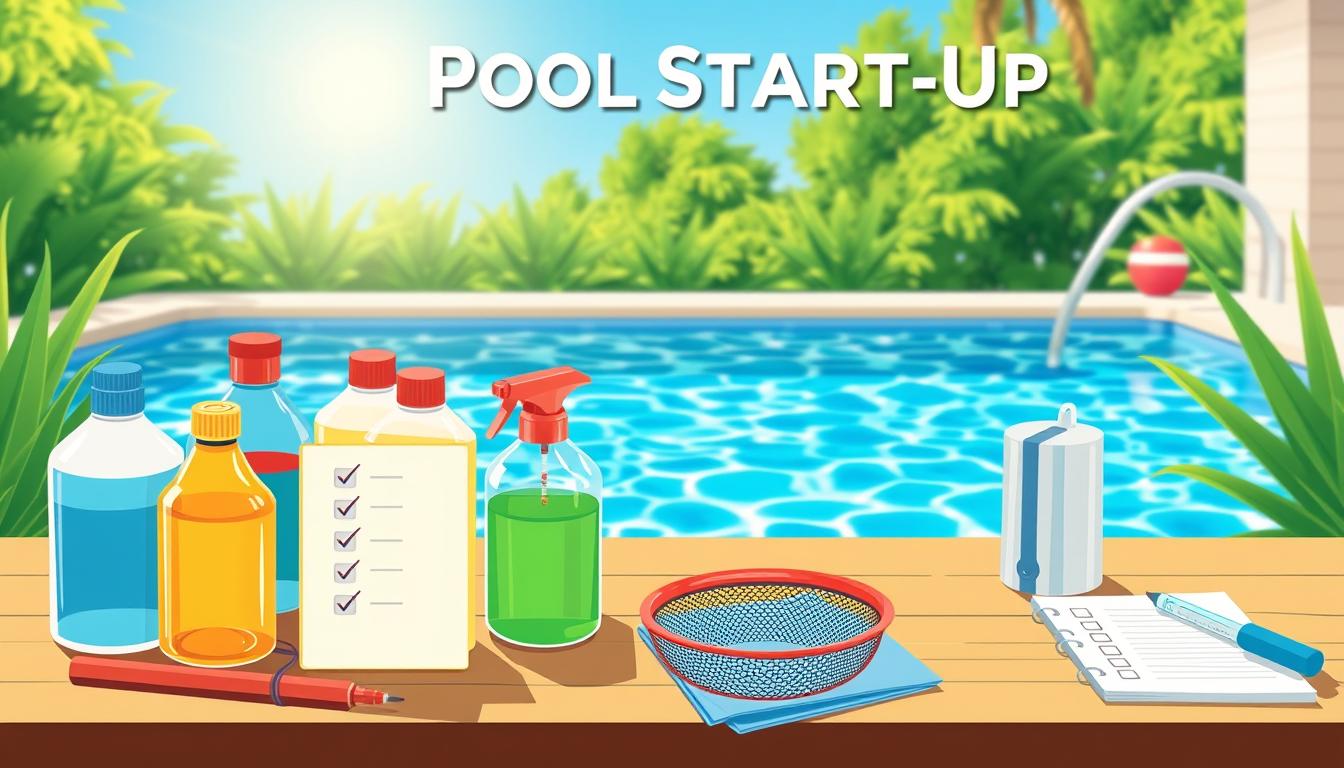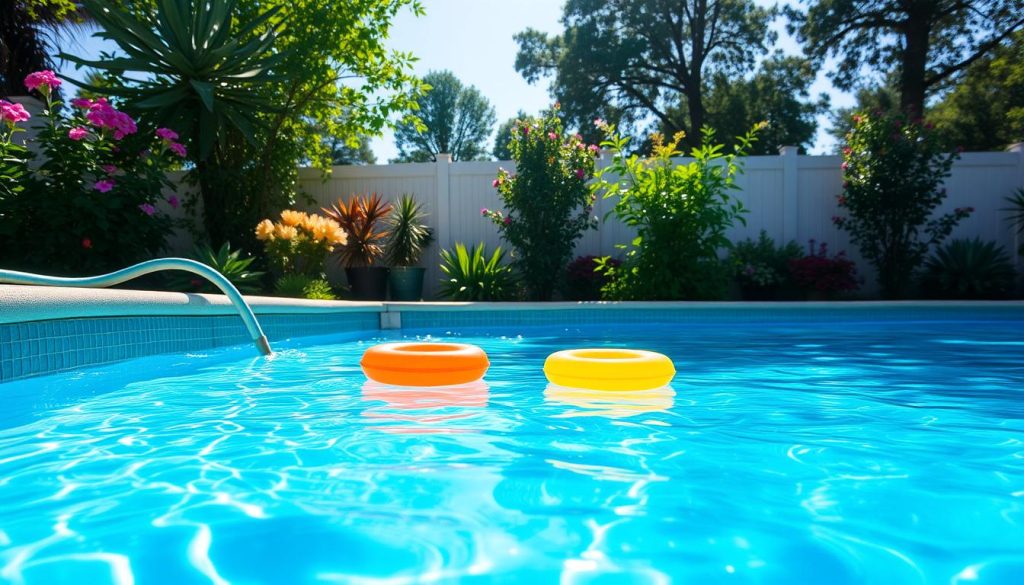
Summer’s approaching, and it’s time to prepare our pools. Opening a pool involves more than just removing the cover. It requires several steps to ensure safe and clean water.
Our family learned this lesson the hard way last year. We’ve created a checklist to help other pool owners avoid our mistakes.
This guide covers crucial aspects of pool maintenance. It includes setting up the filter and priming the pump. We’ll also discuss testing water chemistry and establishing a cleaning schedule.
Following these steps ensures a smooth swimming season. Adhering to safety guidelines is crucial for enjoyment with family and friends.
Our checklist is useful for both new and experienced pool owners. It covers equipment installation, water balancing, and ongoing maintenance. Proper pool opening creates a safe, inviting oasis for summer fun.
Let’s explore the essential steps for a successful pool opening. With the right preparation, you’ll enjoy countless hours of relaxation.
Preparing Your Pool for the Summer Season
Summer’s almost here, and it’s time to get your pool ready. Follow these steps to ensure your pool is clean and safe for use.
Cleaning Up Around the Pool Area
Start by tidying up the pool area. Remove debris and trim the landscaping around the pool. This creates an inviting space for you and your guests.
Removing and Storing Your Winter Pool Cover
Next, remove the winter pool cover. Use a leaf skimmer to clear debris from the cover’s surface. A pool cover pump can remove excess water.
Rinse the cover with a hose and let it dry flat. Check for wear and tear, and replace if needed. Apply mildew remover before storing in a cool, dry place.
Inspecting Your Pool, Equipment, and Chemicals
Examine the pool for damage like cracks or chipped tiles. Check your filter, heater, pump, and cleaners. Replace drain plugs and remove winter plugs from fittings.
Take stock of your pool chemicals. Make sure you have what you need for the season. Essential chemicals include:
- Chlorine tablets
- Shock treatment
- Algaecide
- Stain treatment
- pH adjusters
- Total alkalinity adjusters
- Calcium hardness adjusters
Clean all pool surfaces and equipment thoroughly. This preparation ensures a smooth and enjoyable pool season for everyone.
Filling and Balancing Your Pool Water
Ready to dive into summer fun? Let’s get your pool ready! We’ll fill it up and balance the chemicals. This ensures a safe and enjoyable swimming experience all season long.
Filling Your Pool to the Appropriate Level
Pool water filling requires precision. For above-ground pools, add water until it reaches 2/3 up the skimmer opening. Check for cracks or leaks as you fill.
Inground pool owners should remove plugs and skimmer guards first. Fill to the same level, 2/3 up the skimmer opening. Inspect the surface carefully for any damage.

Testing and Balancing the Water Chemistry
After filling, run the circulation system for at least 12 hours. Then, it’s time for pool water testing. This ensures optimal chemical balance.
Several factors affect your pool’s water balance. These include pH, total alkalinity, calcium hardness, and total dissolved solids. Sanitizer, cyanuric acid stabilizer, temperature, and metal levels also play a role.
Optimal Chemical Levels for a Healthy Pool
Maintaining the right chemical balance is crucial. It keeps your pool safe and inviting. Here are the recommended ranges for key pool water parameters:
| Parameter | Recommended Range |
|---|---|
| Chlorine | 1.0 – 3.0 ppm |
| Bromine | 3.0 – 5.0 ppm |
| pH | 7.2 – 7.6 |
| Total Alkalinity | 80 – 120 ppm |
| Calcium Hardness (Plaster Pools) | 225 – 300 ppm |
| Calcium Hardness (Vinyl, Painted, & Fiberglass Pools) | 175 – 250 ppm |
| CYA Stabilizer | 40 – 60 ppm |
Regular pool chemical balancing keeps these levels optimal. This ensures your pool stays clean, clear, and safe for swimmers.
Shocking Your Pool for a Clean Start
A pool shock treatment protects swimmers from harmful bacteria and contaminants. It uses concentrated chlorine to eliminate unwanted elements. This results in cleaner, safer water.
Add 5-10 ppm of Free Available Chlorine (FAC) during shocking. This controls algae growth and maintains water clarity. After shocking, FAC levels should be 1-4 ppm for safe swimming.
Properly fill your pool, test and balance the water. Perform a thorough shock treatment. You’ll enjoy a sparkling clean and healthy pool all summer long.
New Pool Start-Up Checklist: Final Steps and Ongoing Maintenance
Run your pool filtration system for 12 hours to spread chemicals evenly. Retest the water to check chemical levels. Repeat this process until the water is perfectly balanced.
Vacuum the pool one last time to remove any leftover debris. Use a pool water clarifier for crystal-clear water. Add 1 oz per 5,000 gallons.
Regular upkeep is key for a great pool all summer. Test water chemistry weekly and adjust as needed. This prevents algae growth and equipment damage.
Skim the surface daily and vacuum often to remove debris. Brush walls and tiles regularly to prevent algae buildup. Address problems like cloudy water quickly.
Keep the pool area clean and trim nearby branches. This reduces debris falling into the water. Proper maintenance ensures a safe and fun swimming experience.
Stay on top of daily, weekly, and monthly tasks. This extends the life of your pool components. If pool care becomes too much, consider hiring a professional service.







